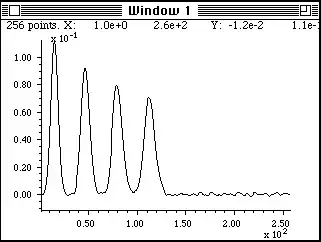Summary: From discrete convolution theorem, it is understandable that we need 2N-1 point DFT of both sequences in order to avoid circular convolution. If we need to do deconvolution of a given experimental M-point signal using the DFT, how do we avoid the circular effects. Do we still need to zero pad the signal to 2M-1 points for DFT deconvolution or not. Some sources say, without explanation, that zero padding is not needed in deconvolution.
It is a well known property of convolution, that convolution of two continuous functions is a multiplication in the frequency domain i.e., y(t)=a*b becoming a multiplication after Fourier transform: F(y(t))= F(a)F(b). This was well known by early 1900s and clearly mentioned in 1941 as discussed in previous questions here.
In practical applications, deconvolution is also desirable. In deconvolution, two functions are divided in the Fourier domain to recover the original function, say a, if y(t) and b(t) are known. For example, if we wish to recover a, we can divide F(y(t)) by F(b) and do an inverse transform to get a. It may not be a mathematically rigorous way, but it is a popular technique in spectroscopy from an empirical perspective.
In majority of the instrumental applications, the function is a discrete and problem is to perform deconvolution using Discrete Fourier Transform. Now the point is that in the DFT, the multiplication of the DFT of two functions yield a circular convolution, not a linear one.
However, one can extract the true linear convolution by ensuring that the length of the DFT equal to 2N-1, where N is the length of the data points contained in the discrete function.
Illustration Suppose x1=[1_,2,3] and x2=[1_,1,1]. We can compute the linear convolution as x3[n]=x1[n]∗x2[n]=∗∗[1_,3,6,5,3]∗∗ If we instead compute x3[n]=IDFTN(DFTN(x1[n])⋅DFTN(x2[n])) we get x3[n]={[6_,6,6]N=3[4_,3,6,5]N=4∗∗[1_,3,6,5,3]N=5∗∗[1_,3,6,5,3,0]N=6
Linear convolution and DFT convolution match when the length of the DFT is at least 2N-1, which is 5 in this case.
Question: Do we need to apply the same length restriction of 2N-1 size of data when wish to divide in the frequency domain or not, in other words trying to do a linear deconvolution using DFT?
- Suppose this is a observed sampled signal with 256 points (left, Window 1). We also know what distorted it by linear convolution. Its length was 256 points.
What people do is that they do a 256 point DFT on the observed signal. DFT is also performed on the distorted function, 256 points.
a) Divide the DFT(observed signal)/DFT(distorting function);
b) Take the inverse DFT, we get
I searched plenty of places, books and papers but could not find a clear requirement about the length of DFT in the case of division/deconvolution. Thanks

